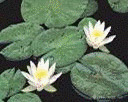 Planting Aquatic Plants Planting Aquatic Plants Gardening with aquatics is similar to other forms of gardening in Plant_11that you have to be aware of proper soil conditions, kinds of containers, proper planting techniques, fertility needs, and after planting care. What makes water gardening unique is that the plants you grow are growing in a water filled environment. Things like water depth, water temperature and what to do with plants during the winter now become a consideration.
Planting Aquatic Plants Planting Aquatic Plants Gardening with aquatics is similar to other forms of gardening in Plant_11that you have to be aware of proper soil conditions, kinds of containers, proper planting techniques, fertility needs, and after planting care. What makes water gardening unique is that the plants you grow are growing in a water filled environment. Things like water depth, water temperature and what to do with plants during the winter now become a consideration.
Soils for Aquatics: Water lilies, lotus, and other aquatic plants do best when they are planted in heavy clay loam soils similar to what you would have in a garden setting. These types of soils are generally well-balanced nutritionally and will support good growth. Commercial potting mixes or other artificial mixes are not used because they are too lightweight and do not hold nutrients for any length of time. So, contrary to other container gardening “rules” do not use an amended soil mix for potting aquatic plants. Use a heavy topsoil with nothing added.
Containers: Most containers used for aquatics are chosen based upon the size of the water garden and the purpose. The size of the pool or pond dictates the size of the container and the types of plants that will be grown. For the most part, containers that are about 15 inches in diameter and 10 inches deep are suitable for hardy water lilies. When planting tropical water lilies, containers that are 20 inches in diameter and 10 inches deep will work well. For other types of plants, containers in the range of six inches to 20 are suitable. The choice will be made based on the plant and the fact that larger containers produce larger plants and smaller containers tend to keep plants smaller in size.
 How to Plant Aquatics Soil used for planting should be damp. Fill containers about two-thirds full of soil. For hardy water lilies, the rhizome should be placed so that the growing point is directed toward the center and at a slight angle. Look for buds or “eyes,” similar to what would be found on a potato to determine which end is the growing point. This is done so that it can grow across the center of the pot. After the rhizome is in place, cover it with soil so that the growing point is just barely above soil level. Tropical water lilies are planted much like hardy water lilies with one exception; they are planted in the center of the pot. Lotus is also planted in the center of the pot. Lotus rhizomes should be handled very carefully though, as they are very brittle and subject to damage. Lotus rhizomes are best planted in large containers and should be covered with about 2-4 inches of soil, keeping the growing tips above soil level. Potting emergent and submerged plants is similar to planting other aquatics. Place some soil in the pot, center the plant and add soil to cover the roots. Another method that works well is to fill the container with soil, wet it thoroughly so it becomes muddy, and gently press the roots of the plant into the soil. Once planted, the soil should be covered with a 1/2 to 3/4 inch layer of pea gravel. This will help prevent soil particals from the soil from clouding up the water and discourage fish from digging into the soil. After planting, water thoroughly and carefully lower the containers into the pond at the proper depth.
How to Plant Aquatics Soil used for planting should be damp. Fill containers about two-thirds full of soil. For hardy water lilies, the rhizome should be placed so that the growing point is directed toward the center and at a slight angle. Look for buds or “eyes,” similar to what would be found on a potato to determine which end is the growing point. This is done so that it can grow across the center of the pot. After the rhizome is in place, cover it with soil so that the growing point is just barely above soil level. Tropical water lilies are planted much like hardy water lilies with one exception; they are planted in the center of the pot. Lotus is also planted in the center of the pot. Lotus rhizomes should be handled very carefully though, as they are very brittle and subject to damage. Lotus rhizomes are best planted in large containers and should be covered with about 2-4 inches of soil, keeping the growing tips above soil level. Potting emergent and submerged plants is similar to planting other aquatics. Place some soil in the pot, center the plant and add soil to cover the roots. Another method that works well is to fill the container with soil, wet it thoroughly so it becomes muddy, and gently press the roots of the plant into the soil. Once planted, the soil should be covered with a 1/2 to 3/4 inch layer of pea gravel. This will help prevent soil particals from the soil from clouding up the water and discourage fish from digging into the soil. After planting, water thoroughly and carefully lower the containers into the pond at the proper depth.
Planting Aquatics
Placing Plants in the PondHardy water lilies will grow well at water depths of 12-18 inches Plant_31over the top of the pot. The plant can be placed in the pot at an initial depth of six inches and then lowered to its final placement or 12-18 as the plant grows. If the pond is in full sun, the minimum amount of water over the top of the pot should be from 6-8 inches for the plant to grow well. If the pond is in the shade (less than six hours of sun a day), then six inches of water is sufficient in order for the growing tip to receive enough light. Tropical water lilies prefer to grow at water depths of 12 inches but will tolerate 6-8 inches of water. Lotus is usually grown with 4-6 inches of water over them while emergent water plants can be grown in soil that is constantly wet or with 2-4 inches of water over the top of them. In order to conveniently adjust the water depth over the pots, bricks or inverted pots can be used as props under the plants to position them. As plants grow, the depth can be easily adjusted by adding or taking away supports.
Timing the Placement of Plants in the Pond Hardy water lilies, lotus and emergent plants are tolerant of cooler water temperatures and can be placed in the pond when temperatures reach about 50 degrees. Tropical water lilies and some floaters cannot tolerate cold temperatures and should not be placed in the pond until the water temperature reaches at least 70 degrees. Placing them out too early can cause dormancy, injury and restrict potential growth of the plant.
Tropical water lilies are handled differently because of their tropical nature. Prior to the first frost, remove these plants from their pots and trim off most of the leaves and roots. Repot into smaller containers and store in an aquarium tank or other container where they get plenty of light and where the temperature can be maintained at about 68 degrees. Some tropical water lilies produce walnut-sized tubers. These can be removed and stored in water at 55-60 degrees for the winter. When placed in warm water (70-75 degrees), they will sprout. They can then be potted in small pots and move to the pond at the appropriate time. Placing them out too early can cause dormancy, injury and restrict potential growth of the plant.
Fertilizing Aquatic Plants Fertilizers contain minerals that are used by plants for growth and development. There are many factors that may determine the amount and type of fertilizer to use such as amount of sun, temperature, water, and type of plant. Each plant varies on its requirements. It should be noted that fertilizers are not used to correct cultural problems. So, if the environment is not right, the use of fertilizers will not help the plant. Also remember that over fertilization can lead to algae problems. Generally, slow release tablets are acceptable.The recommended rate for water lilies and lotus at the time of planting is four ounces of fertilizer for every one cubic foot of soil mixed into the soil. After that, monthly applications can be made up until about August. Tablet forms of fertilizer are the most convenient to use as they can be pushed into the soil. Emergent water plants can be fertilized at planting and once at midseason at about half the rate recommended for water lilies.
Overwintering and Storing Aquatic Plants There are several ways to store hardy water lilies and emergent aquatic plants. For all the methods that can be found, there are some basic requirements that must be met and remain the same in all cases. One, the plants must go dormant by keeping them in a cool location (50 degrees maximum).Also, they must not be allowed to dry out and, their roots must not be allowed to freeze. In shallow ponds and container aquatic gardens, plants will need to be brought in for the winter. Just after the first frost, lift the containers from the pond and leave the plants in the pot. Trim off all dead leaves and stems. Place the container in plastic bags to retain moisture and store in a cool basement or other area where the temperatures don’t go above 50 degrees or below freezing. Check periodically to make sure that there is plenty of moisture in the bag. Maintain these conditions until spring. Another way to overwinter these plants is to remove the rhizomes from the pots, prune all old leaves and stems, and store them in damp sphagnum moss placed in plastic bags. Store in an area that is cool (50 degrees) until spring.

